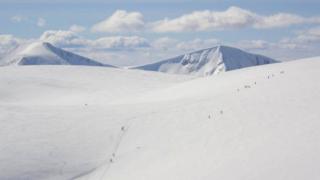
Image copyright
SAIS Northern Cairngorms
The Cairngorm Plateau is the kind of condition winter enthusiasts hope for
Winter in Scotland conjures up images of the snow-topped mountains which attract visitors in their droves every year for walking, climbing and snowsports.
But enthusiasts say they have noticed a difference in recent years, with milder weather leading to less snow cover.
What have conditions been like this winter?
It has snowed this year, and is expected to do so again when Storm Ciara hits Scotland in the coming days, but lots of what has fallen has melted in thaws or been stripped away by strong winds.
Ben Dolphin, president of Ramblers Scotland and a winter walking enthusiast, said it wasn’t unusual for conditions to vary from year to year on the hills.
But he added: “I don’t know any Scottish winter enthusiast who’d feel at ease with what’s happened for the last two years, or who would think those winters fit into the ‘normal’ pattern of mild and cold winters.
“It’s not just the lack of snow, it’s the high night-time temperatures, and the longevity and persistence of mild weather patterns.”

Image copyright
Paul Noble/SAIS Southern Cairngorms
A mountain hare in its winter coat looking exposed without snow cover in the Southern Cairngorms in December
He said warm air was being drawn up from the Azores for weeks at a time.
“These recent winters do feel different. I’ve been up here a lot over the years, always in January or February, and I’ve never seen it looking as snowless as this.”
Lee Schofield, of Highland and Islands Weather, offers free weather observations to tourists visiting the Cairngorms.
He said temperatures in his home village of Carrbridge were 3.5 degrees higher last month than they were in January 2019.
“That is a considerable difference and well above the normal we would expect to see,” he said.
“Between Christmas and New Year a very warm plume of air brushed past the north west and this set new December high temperature records for the UK.”
Mr Schofield added that Achfary in north west Sutherland recorded 18.7C one night – which was higher than the area’s average maximum temperature in summer.
What has been causing these conditions?
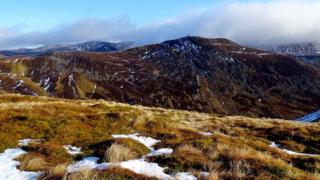
Image copyright
SAIS Southern Cairngorms
The scene in the Southern Cairngorms earlier this winter
The Mountain Weather Information Service provides weather forecasts to aid mountain safety for 10 upland regions across the UK, including the west Highlands, Cairngorms and Southern Uplands in Scotland.
Forecaster Garry Nicholson said Scotland had been feeling the effects of fluctuating air masses between milder tropical maritime southwesterlies and colder polar maritime northwesterlies.
This has brought cycles of freeze and thaw through the winter.
“There have been some lengthy periods of sub-zero conditions on the Scottish mountains with snowfalls, but there have also been episodes of much warmer temperatures and a marked thaw,” he said.
“On balance, we have lacked periods of prolonged cold air, and although there has been snow, we’ve been lacking a really substantial snowfall and consolidation across the hills.”
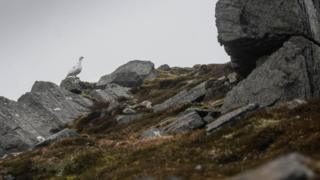
Image copyright
Paul Noble/SAIS Southern Cairngorms
Ben Dolphin has concerns for “winter specialist” wildlife such as ptarmigan
The cause can be traced back to the Polar vortex, which has been strong this year.
“Westerly winds around the Arctic Circle have been more constant, which hasn’t allowed lobes of Arctic air to escape into the mid-latitudes as can sometimes be the case,” Mr Nicholson said.
“Whilst the weather patterns this winter are part of natural variability over the north Atlantic, these ‘westerly winters’ have been generally more common in the past couple of decades as global temperatures have risen.”
He said there had been some notable exceptions, such as in 2010, 2013 and most recently in 2018, when the Beast from the East brought low temperatures and heavy snow.
What is the impact of milder winters?
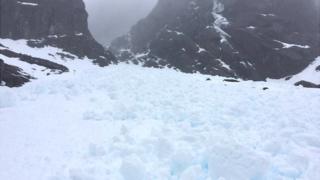
Image copyright
SAIS Lochaber
It feels mild but mountain winter risks remain as this avalanche debris on Ben Nevis in January shows
Mountaineering Scotland, which represents the interests of climbers, walkers and skiers, warns that the conditions should not give visitors to Scotland’s hills a false sense of security.
It urges people to check mountain weather forecasts and avalanche risk assessments – about 40 avalanches have been recorded by the Scottish Avalanche Information Service this season.
It recommends that people should carry ice axes and crampons, as well as suitable clothing for sudden changes in the weather.
“Winter is always a fickle season in the Scottish mountains, and ideal conditions are often elusive and short-lived – and certainly hard to predict in the long term,” a spokesman said.
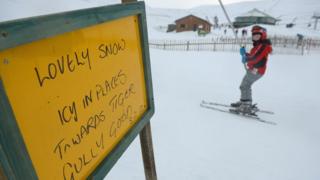
Image copyright
Getty Images
Scotland experienced colder conditions in the winter of 2013
Scotland’s mountain ski resorts have had to invest in snow-making factories to try and guarantee snowsports on lower slopes.
Almost 100 tonnes of snow was artificially produced every day for more than a month at Cairngorm Mountain, near Aviemore, in preparation for the start of its winter season in December.
Other mountain ski resorts, including Nevis Range near Fort William, have also invested in snow-making equipment.
Warmer weather has also led to the closure this weekend of the Cairngorm Sleddog Centre at Aviemore after 20 years.
Alan Stewart, who runs the centre with his family, said this was due to a lack of snow and higher temperatures. For welfare reasons, he does not run the sled dogs at temperatures of over 10C.
“It’s not rocket science,” he said. “It’s climate change.”
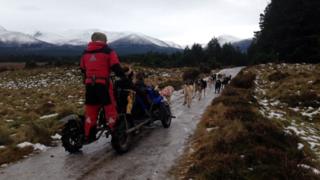
Image copyright
Alan Stewart
Alan Stewart says higher temperatures and a lack of snow have affected his sled dog business
He added: “The temperature is the main thing. It started becoming an issue five years ago – there is no snow, only heavy sleet and rain, and trails never get a chance to dry out.”
Concerns have also been raised about the impact of mild winters on the environment.
Ticks, which can spread a harmful infection to humans, emerged early last February due to warm weather. The arthropods usually start to emerge in March.
Mr Dolphin, who works as a countryside ranger, said it was also possible to see more tree diseases and pressures on mountain wildlife.
“It doubtlessly means our winter specialists like ptarmigan being pushed up the hills with the snowline, and some plant or moss species that rely upon summer snow patches for their long-term survival, disappearing completely,” he said.
All pictures are subject to copyright.









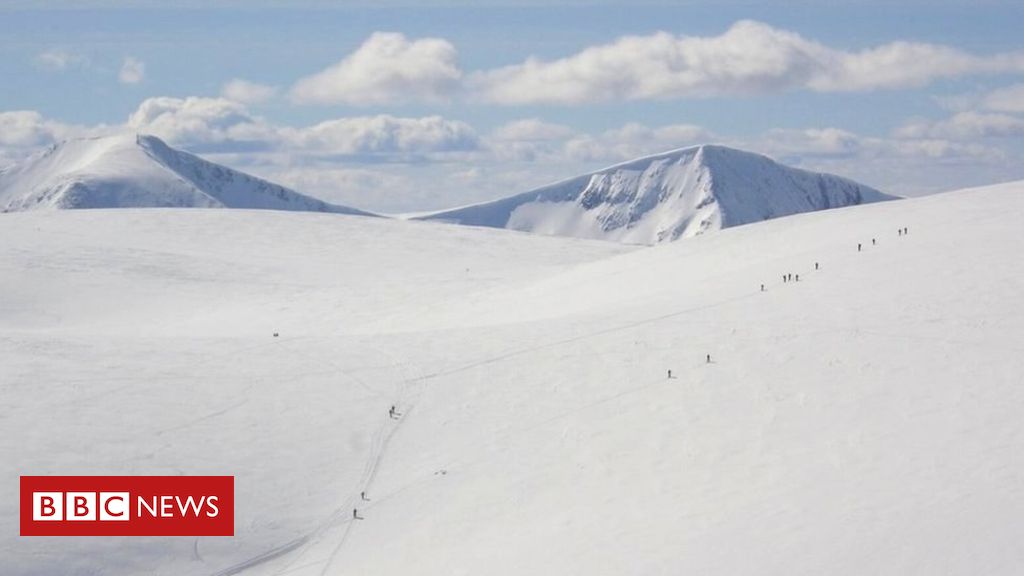







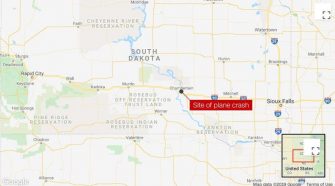
Democratic women in Congress hold press conference to address Trump’s racist tweets and “Made in America” comments – live updates